Fish that don’t need filters: Of course, the cheapest tanks are unfiltered, and most people want to know if they can keep their fish in an unfiltered tank.
Every fish does not need oxygen to breathe. But some species can absorb oxygen directly from the air in addition to oxygen dissolved in water.
Among them are the Bettas, Gouramis, and other Anabantidae. Let’s talk about the requirements of these fish and what precautions we should take when keeping fish that don’t need filters.
Why do fish need a filter?
Fish that don’t need filters are much more tolerant to polluted water. The main excretory product of fish is ammonia, which they release into water directly.
This increase in the ammonia level in the water depends on the number of feeds given to the fish, the quality of the meals, the excellent acceptance of the feeds, correct maintenance, the size of the fish, and the volume in the tank.
The less they feed and excrete, the less they pollute the water. Some fish are also hardy, which means they can survive even in unfavorable conditions. But that’s not to say that, in the long run, it doesn’t cause severe problems for them or might even malfunction.
How fish breathe underwater
The gills or gills facilitate what is called water breathing. The water enters the fish’s mouth and goes to the gills. There, the blood receives oxygen. It then expels carbon dioxide through the operculum, the holes on each side of the fish’s head.
Examples of fish that don’t need filters or heaters
A goldfish is one of the most common aquarium fish. Does not require filtration or an electric heater. Guppies are excellent pets that can survive without heaters or filters.
The Danio zebra is an inexpensive fish that makes a good pet for an aquarium. If you want to maintain a healthy aquarium and well-stabilized water parameters for your fish, you should change the water frequently.
It is always essential to clean the bottom of the aquarium, where waste is concentrated. Partial water change helps bring ammonia levels below a critical level.
Why do fish need a water heater?
Fish depend on the temperature of the water in their environment to control their internal temperature. In their natural habitat, some fish prefer cold water, while others prefer warmer water.
If you have cold-water fish in your aquarium, you don’t need a water heater because their temperature is suitable. For cooler climates but you want freshwater fish, a heater is required.
Now that you understand the reasons for using the filter and heater, I’ll give examples of fish surviving without them. Examples of fish without a heater and others without a filter.
What kind of fish can live in a bowl
Most bowls are tiny, without filters or decoration. Fish that are very hardy, tiny, and potentially cold-water species are recommended.
Tough fish like the white cloud goldfish can handle variations in water parameters more smoothly. Small fish in small space and less water and can make great bowl choices.
Coldwater fish may require a daily routine water change. If you don’t have a heater, you probably don’t want a fish that doesn’t need a constant temperature of 78F like a Betta fish if you can’t heat the water.
Smaller species such as Scarlet Badis are good choices.
The best fish to keep in a fish bowl
Bettas are by far the most suitable fish for bowls. We also have White Cloud Minnows are small fish but very active, with small red tips, but they like to swim in shoals.
They are super resistant and can tolerate significant variations in water quality for some time. They live in cold water, and therefore you don’t need the heater. If you add some snails or shrimp, they won’t bite these animals.
Types of fish that should not be kept in bowls
Fish that are predatory and large should not be thrown into bowls. This type of fish requires a much more intense filtration and oxygenation system to supply its minimal needs. Here are some excellent examples of fish you should avoid: The oscar fish, discus, angelfish, plecos, and more.
How we reviewed the following fish that don’t need filters
We have experts that have worked on animals in pet stores who have observed the different species. The main characteristics looked at were prices, colors, and the ease of maintenance. We’ve tried being as objective as we can about these fish.
Betta fish are perfect for a bowl.
Bettas are a fish that don’t need filters. They are an exotic fish, famous for their long, colorful tails. The male is highly aggressive with fish of the same species, while females can live with others. Contrary to what many people believe, it should not be kept in aquariums smaller than 10 gallons.
It is a small fish, which stays alive in a bowl without a filter. Still, it is necessary to keep it with heaters to avoid sudden fluctuations in temperature, depending on where you live, especially in tropical regions where temperatures fluctuate daily.
But the most important rule is to always keep one betta fish per bowl. It’s a fish with an enormously vast range of colors.
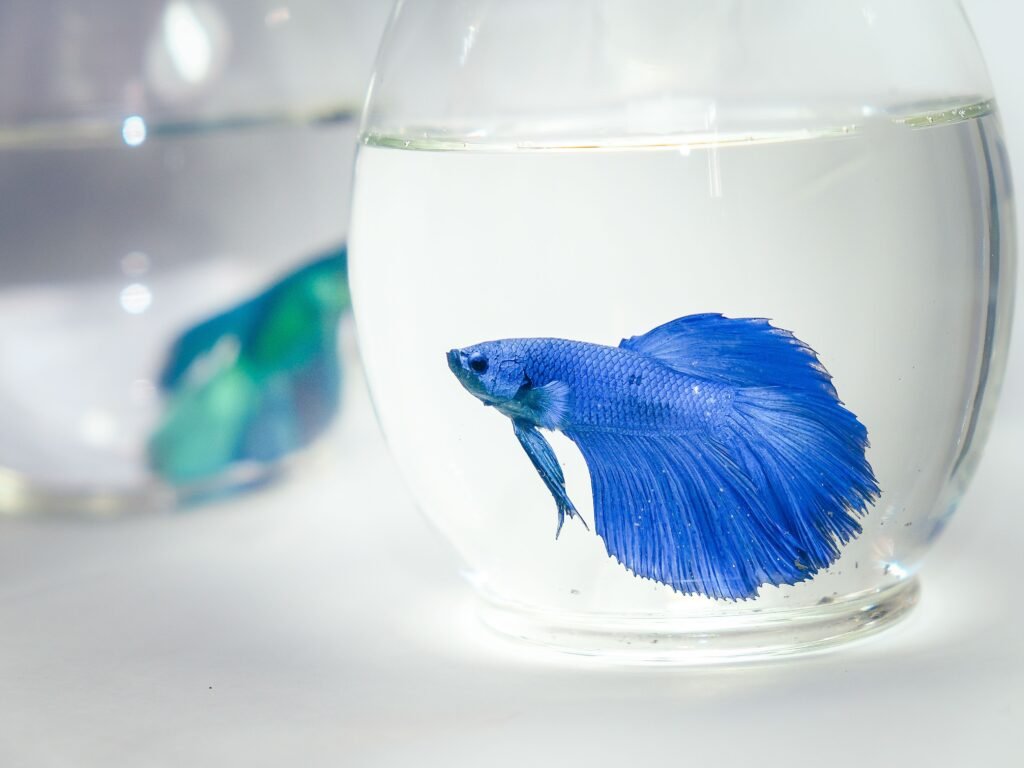
Least Killifish
These small fish are very easy to care for and are an excellent choice for those looking for a species they won’t spend a lot of time with.
Due to their small size and peaceful nature, you can have them in large groups and with a wide variety of other species.
Many modern aquarists know that these fish are average fish, especially males because they have them in their tanks. There are big fans of killifish, especially if you plan to keep the water temperature lower.
You can have a variety of aquatic plants and mosses; they like, decorate, and help in the general stability of the water quality, making partial changes less frequent. It’s a fish with a wide range of colors.

Zebra Danios easy to take care
Zebra Danios has a loyal following in the freshwater aquarium community. It’s a lot of fun to see these fish playing and swimming in groups.
You can keep them in small, warm aquariums without worrying about their diet or interaction with other fish. With a temperature range of 20°C, it is possible to keep these tanks at lower temperatures without problems.
They are not fish that require a biological filter if the water changes are correctly done. These fish are important because they have a longer lifespan. They have very soothing properties that you can combine with many different plants.

The Danio Celestial
Galaxy rasbora is one of the few freshwater species that we keep in cold water tanks. These fish are peaceful and friendly.
The Danio Celestial Pearl, a famous name, is an exquisite species that many aquarists love small fish. Do not exceed 1.5 inches. So it’s pretty evident that they don’t need a lot of gallon tanks. Their colorful pattern makes them a fantastic choice for any aquarium looking for some color.
Despite their unique characteristics, these fish sometimes don’t stand out from others and can become challenging to identify in the wild based on their appearance.
These fish are best for small, well-designed aquariums. They were widely used with shrimps and low vegetation aquariums. They usually stand out more quickly in aquariums with a white background and green plants.
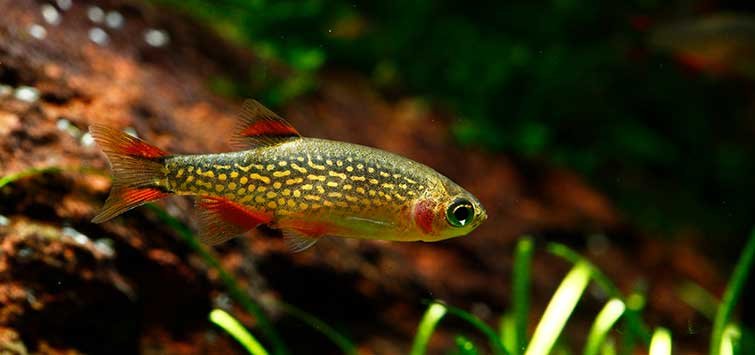
Empire Gudgeon
Empire Gudgeon is full of exciting colors and behaviors. Plus, it’s easy to maintain. You will need some maintenance from time to time, but if you have built an excellent habitat. They can thrive in all water conditions and are easily kept in cold water.
They also have beautiful colors. Most aquarists know them because most like them in small bowls, up to 10 gallons. They adapt well and have unique and striking behavior.
They are very active and interact with the aquarists, especially in the feeding frenzy. And it’s another variety of fish that lives well without a filter.
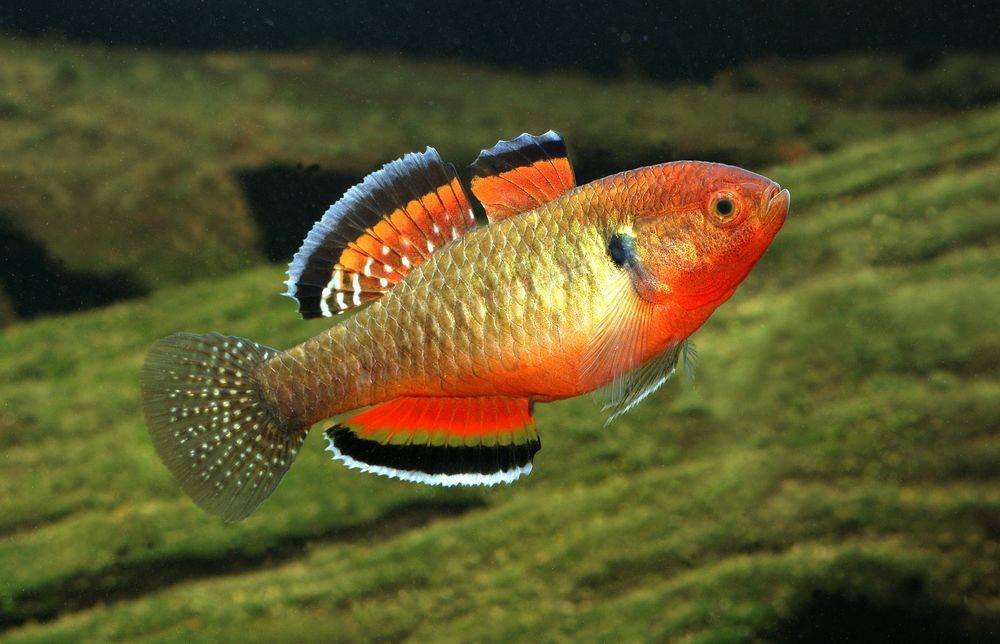
Paradise a strikingly colored fish
Fish with a striking appearance, drawing attention due to its blue and red stripes. It’s not a very peaceful fish; it can be territorial. Keeping it in a minimum school of 6 fish can help reduce aggression.
A properly sized aquarium is also essential. They are resistant to variations in water parameters, quickly adapt to various types of feed, and are very fond of plants in their environment, which also helps avoid any conflicts.
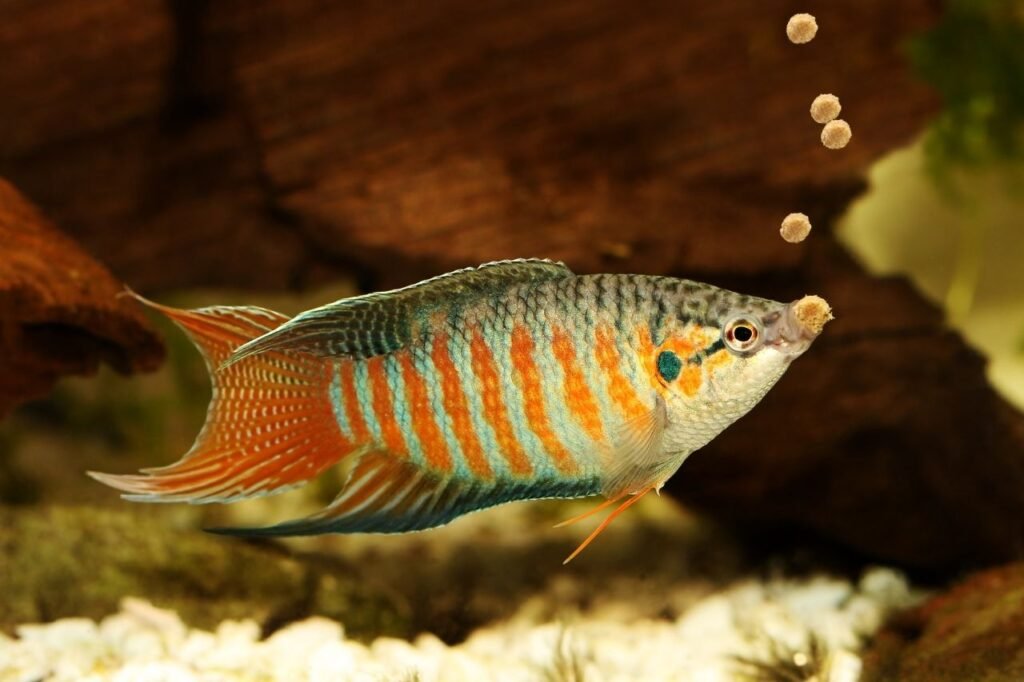
Cherry Shrimp in a bowl
When considering fish that don’t need filters, why not consider shrimp.
Neocaridina davidi has an excellent reputation among fish farmers in Asia for its bright, Skittl-like tones. They can be easily bought and sold at pet stores.
Start with 10 or 20 prawns for a 10 gallons bowl, make sure they keep enough calcium and minerals in the water, and soon you’ll have beautiful baby prawns. Shrimps were originally brownish-gray in appearance but have been cultivated in many.
They will not exceed 2 inches. Different colors like blue, red, white, red-orange, and black. They can be combined with galaxy rasboras, but you must pay attention to the general quality of the water, maintain more intense maintenance and try to offer the best quality feed possible. And it doesn’t need a heater or filter.

Medaka Ricefish
This fish carries two names. Medaka rice fish and Japanese rice fish. Some believe that some of these fish should technically belong to the killifish family.
This species is an excellent choice if you want a fish that will get along with everyone. This fish is simple to feed and maintain, and it also reproduces quickly.
This is undoubtedly a species to consider for fish to put in bowls with little water gallons. They are very resistant to temperature changes, in addition to having good tolerance to suitable pH ranges. They adapt very well to other fish of the same size and behavior.

Pygmy Sunfish is an excellent small fish.
The pygmy Sunfish is a cold-water fish; it handles low temperatures very well, it doesn’t do well when temperatures are high. They have striking but straightforward colors.
It is a popular fish for its distinctive appearance and ease of care. It is a species that has a dedicated following among aquarists for many different reasons (besides color).
If you love the color red, green, and blue, you will love this fish. This species is highly vibrant and will add a new visual dynamic to any aquarium they live in.
It is remembered that colors vary from females to males. It has a peaceful behavior and loves to be among plants and mosses.

The curious kisser fish
Fascinating fish are due to their behavior of “kissing” other members of the species. This behavior is believed to be linked to dominance disputes among fish.
It is peaceful but can become aggressive towards other Gouramis. It should be kept in large aquariums due to its size, reaching many tens of centimeters.
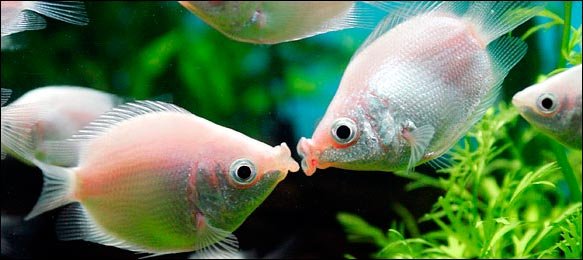
Pethia conchonius, the famous barbs.
Pethia conchonius is a fish species whose adults are found in a slightly lotic environment, but they occur in numerous types of habitats, from streams to deeper water tributaries. Distributed in Afghanistan, Pakistan, India, Nepal, and Bangladesh. Reported from Myanmar.
Introduced around the world and very popular with hobbyists. It is one of the most resistant barbs, undemanding, and impressive coloration during the breeding period.
Wild specimens vary in color and size according to the region of occurrence. Selective breeding has produced several ornamental strains, including long-tailed, super red, neon, and gold forms.
It has also been hybridized with some congeners, although apparently, the offspring of such experiments are infertile.
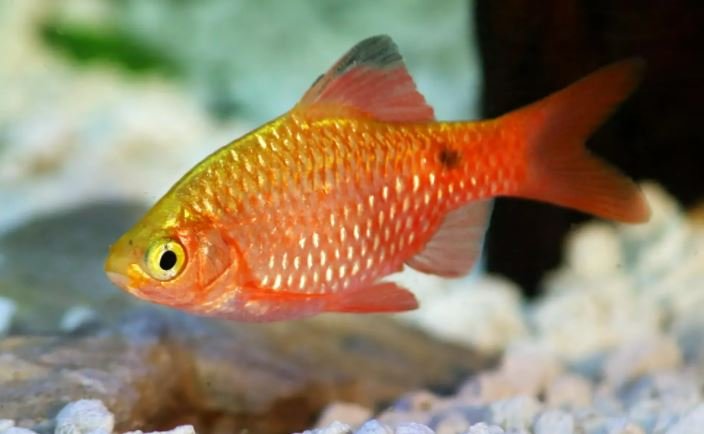
A one-sided livebearer or Jenynsia
The one-sided live bear is a simple but elegant fish that can thrive at cooler temperatures. This species is peaceful and hardy. It is usually best to store this species exclusively in a 10-gallon tank.
Its name comes from the relationship between the two sides. Its behavior is quite exciting and should please any breeder! If you are interested in creating, it might be of interest to you, if you will.
They are known as cold-water species. It thrives in high-density cold water in aquarium waters. It is a genus of freshwater fish in the Anablepidae family.
Like Anableps species, they are unilateral carriers: some sources indicate that they only mate on one side, “right-handed” males with left-handed females and vice versa. However, other sources dispute this. But it’s a fish that you can easily keep without a filter.
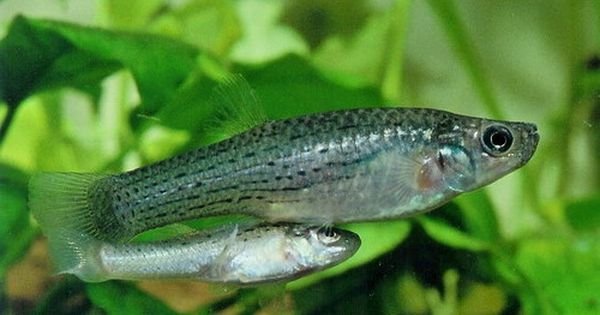
Hillstream Loach or Balitoridae
Mountain loaches (Sewellia lineolata) eat brown diatoms and green algae. Hillstream loaches have more ideal water temperatures and a pH ranging from 6.6 to 7.8.
If you’ve fed them well, you’ll notice their breeding habits, and babies show up everywhere. In addition to eating seaweed, they like good quality Repashy foods in gel and wafer.
They are still water fish, but keeping the partial change at least three times a week is interesting. Quality power and correct light. However, it is a freshwater fish from currents, so, interestingly, you have a circulation pump to keep oxygenation high.

Trichogaster trichopterus – Blue gourami
Peaceful species, when in properly sized aquariums, can become territorial in small aquariums. There are several types of coloration, and fish are considered to be very resistant.
Its behavior will vary from individual to individual, although it is often considered peaceful and recommended for community aquariums. Some individuals can become aggressive as they mature, especially when kept in a small aquarium or a few plants.

Plants in your fish bowl
Plants not only help to improve the appearance of the aquarium, but they also provide many benefits. Aquarium plants go through the photosynthesis process to grow during the day (or when the lights are on).
They absorb carbon dioxide from the water (produced by the by-product of fish respiration) and use light as energy to convert this dioxide into oxygen.
Final Thoughts – fish that don’t need filters
Not all fish can withstand unfiltered water, but the ones mentioned are tougher and more challenging than others. Always keep your fish warm when needed. This way, you can keep your fish for many years – although you cannot constantly filter your water.
The notion of owning fish that don’t need filters or a heater may seem strange to some. The strange feeling that fish are going to die from lack of care.
But this will save you some money and allow you to experiment with maintaining a more natural aquarium.
We are committed to making our guides the best they can be, and we appreciate the help of our readers to help us prevent our fish from being kept in cold water tanks without filters.





![Top [2023] 9 Best Betta Fish Food – Betta Feeding Guide Best Betta Fish Food](https://aquariumhunter.com/wp-content/uploads/2021/03/betta-fish-food.jpg)

